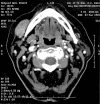Myoepithelioma of a minor salivary gland of the cheek: case report
- PMID: 18383757
- PMCID: PMC2639949
Myoepithelioma of a minor salivary gland of the cheek: case report
Abstract
Myoepithelioma is a rare neoplasm of the salivary glands, generally occurring in the parotid gland and less often in the minor accessory salivary gland of the oral cavity. The histological appearance includes solid, myxoid and reticular growth patterns. Vimentin and S-100 protein are very sensitive but non-specific immunohistochemical markers of neoplastic myoepithelium. Conservative surgery is the treatment of choice. A case of myoepithelioma of the minor salivary gland of the cheek with low grade malignancy is described, focusing on clinical behaviour, histopathological and immunohistochemical features and differential diagnosis.
Il mioepitelioma è un raro tumore delle ghiandole salivari che coinvolge generalmente la ghiandola parotide e meno frequentemente le ghiandole salivari minori della cavità orale. Da un punto di vista istologico si distinguono tre diversi pattern di crescita: solido, mixoide e reticolare. Da un punto di vista immunoistochimico la vimentina e la proteina S-100 rappresentano dei markers molto sensibili ma non specifici di neoplasia mioepiteliale. La chirurgia conservativa radicale è il trattamento di scelta. Viene discusso un caso di mioepitelioma di ghiandola salivare minore della guancia a basso grado di malignità, enfatizzando il comportamento clinico, le caratteristiche istopatologiche e immunoistochimiche e la diagnosi differenziale.
Figures



Similar articles
-
Product definition in a case of myoepithelioma.Oral Surg Oral Med Oral Pathol. 1986 Aug;62(2):169-74. doi: 10.1016/0030-4220(86)90040-x. Oral Surg Oral Med Oral Pathol. 1986. PMID: 2427986
-
[Salivary gland myoepithelioma].Acta Otorrinolaringol Esp. 2001 Apr;52(3):269-72. doi: 10.1016/s0001-6519(01)78207-6. Acta Otorrinolaringol Esp. 2001. PMID: 11526873 Spanish.
-
Cytomorphological features of a metastatic myoepithelial carcinoma arising in a minor salivary gland.Diagn Cytopathol. 2005 Jul;33(1):56-7. doi: 10.1002/dc.20145. Diagn Cytopathol. 2005. PMID: 15945094 No abstract available.
-
[Myoepithelial carcinoma (malignant myoepithelioma) of the salivary glands. A case report].HNO. 1998 Jan;46(1):66-9. doi: 10.1007/s001060050200. HNO. 1998. PMID: 9539060 Review. German.
-
Myoepithelial carcinoma of the retromolar area in a young female. A rare case report.Med Oncol. 2010 Sep;27(3):946-9. doi: 10.1007/s12032-009-9314-9. Epub 2009 Sep 22. Med Oncol. 2010. PMID: 19771533 Review.
Cited by
-
A Case of Myoepithelioma of the Nasal Cavity.Indian J Otolaryngol Head Neck Surg. 2019 Nov;71(Suppl 3):1745-1747. doi: 10.1007/s12070-017-1093-6. Epub 2017 Feb 3. Indian J Otolaryngol Head Neck Surg. 2019. PMID: 31763237 Free PMC article.
-
Myoepithelioma- An Uncommon Parotid Tumour in An Adolescent.Indian J Otolaryngol Head Neck Surg. 2024 Feb;76(1):1168-1173. doi: 10.1007/s12070-023-04199-x. Epub 2023 Sep 7. Indian J Otolaryngol Head Neck Surg. 2024. PMID: 38440509 Free PMC article.
-
Palatal plasmacytoid myoepithelioma.Adv Biomed Res. 2012;1:78. doi: 10.4103/2277-9175.102985. Epub 2012 Oct 31. Adv Biomed Res. 2012. PMID: 23326808 Free PMC article.
-
Myoepithelial Carcinoma Arising in a Plasmacytoid Myoepithelioma of the Parotid Gland Synchronized with Melanoma: A Case Report and Review of the Literature.Case Rep Oncol. 2021 Mar 1;14(1):173-183. doi: 10.1159/000510937. eCollection 2021 Jan-Apr. Case Rep Oncol. 2021. PMID: 33776700 Free PMC article.
-
Cystic clear cell myoepithelioma of the parotid gland. A case report.Oral Maxillofac Surg. 2009 Mar;13(1):45-8. doi: 10.1007/s10006-009-0145-9. Oral Maxillofac Surg. 2009. PMID: 19214604
References
-
- Martinez-Madrigal F, Micheau C. Histology of the major salivary glands. Am J Surg Pathol 1989;13:879-99. - PubMed
-
- Sciubba JJ, Brannon RB. Myoepithelioma of salivary glands: report of 23 cases. Cancer 1982;49:52-72. - PubMed
-
- Batsakis JG. Myoepithelioma. Ann Otol Rhinol Laryngol 1985;94:523-4. - PubMed
-
- Seifert G. World Health Organization international histological classification of tumours. Histological typing of salivary gland tumours. 2nd Edn. Berlin, Heidelberg, New York: Springer 1991.
-
- Katsuyama E, Kaneoka A, Higuchi K. Myoepithelioma of the soft palate. Acta Cytol 1997;41:1856-8. - PubMed
Publication types
MeSH terms
Substances
LinkOut - more resources
Full Text Sources
Medical
